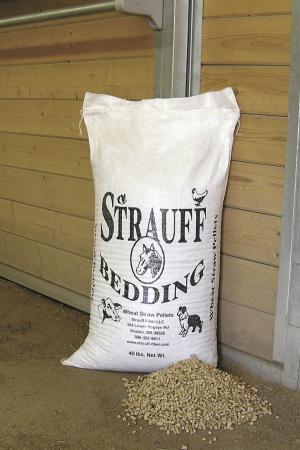2009 - Volume #33, Issue #4, Page #03
[ Sample Stories From This Issue | List of All Stories In This Issue | Print this story
| Read this issue]
They're Turning Straw Into Gold
 |
Their high-yield wheat fields produce four to five tons of residue per acre and they see it as a high value crop.
"By connecting a baler directly to the combine using the combaling system, we pick up all weed seeds, chaff, broken grain and straw," explains Coombs. "Adding the chaff, leaves and other residue to the straw makes it possible to pelletize it. We couldn't do this with wheat straw alone."
After having the contents of several bales custom-pelletized, Coombs and Shoun, along with two partners, started Strauff Fiber, LLC. They bought and modified a pelleting machine and began marketing wheat residue pellets for horse bedding.
Coombs says the pellets will absorb as much as 300 percent of their weight in moisture. They also decompose faster than wood shavings, which give them added value as compost or manure.
Other new marketing opportunities are appearing as people learn about the pellets. "We've had interest from the forest service in using them for erosion control," says Coombs. "They can drop them by air on exposed soil to create an erosion prevention mat. The pellets practically explode when exposed to moisture."
The bales produced behind the combine also have significant value as livestock feed. After testing nutrient value, several large cattle feeders have offered to buy all the bales Coombs and Shoun can produce.
The two are also investigating the use of the pellets as fuel. Due to their compact nature and ease of transport and handling, many other uses are also being considered. Coombs says the two haven't had time to even look into adding grass seed or fertilizer to the pellets.
Contact: FARM SHOW Followup, Strauff Fiber LLC, 324 Lower Hogeye Rd, Dayton, Wash. 99328 (ph 509 382-9611; cell 509 520-6411; Strauff.fiber@live.com; curtis@strauff-fiber.com).

Click here to download page story appeared in.

Click here to read entire issue
To read the rest of this story, download this issue below or click here to register with your account number.




